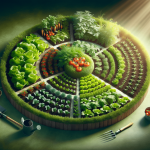This post may contain affiliate links. As an Amazon Associate, we may earn commissions from qualifying purchases.
Welcome to a delightful journey into the fascinating world of plant breeding and hybridization! In this easy-to-understand guide, you’ll discover the essentials of creating new plant varieties with desirable traits. As you navigate through the basics, you’ll learn how gardeners like you can selectively breed plants to boost characteristics such as disease resistance or drought tolerance. Unleash your inner botanist and see how simple techniques in plant breeding can transform your garden into a resilient, thriving paradise. Have you ever wondered how you can improve your garden plants to withstand diseases, tolerate droughts, or even produce bigger and healthier fruits? It all comes down to plant breeding and hybridization, techniques that have been employed for centuries. These techniques aren’t just for professional botanists; gardeners like you can harness them to create more resilient and productive plants. Let’s dive into the fascinating world of plant breeding and hybridization to explore how you can enhance your garden’s flora.
What is Plant Breeding?
Plant breeding is the science of altering the genetics of plants to produce desired traits. This can involve crossing plants to create hybrids, selecting plants with preferred traits, or even manipulating genes at a molecular level. The ultimate goal is to enhance characteristics like yield, disease resistance, drought tolerance, and overall plant vigor.
Why is Plant Breeding Important?
Plant breeding isn’t just a scientific curiosity; it’s crucial for food security, ecosystem maintenance, and even the economy. Imagine a world where crops are more productive and require fewer chemical inputs—that’s the promise of effective plant breeding.
Historical Context
Plant breeding dates back to the dawn of agriculture. Early humans would select seeds from plants that displayed desirable traits, setting aside these seeds for the next planting season. Over time, this selection process led to the development of various crop varieties suited to different climates and needs.
The Basics of Hybridization
Hybridization is a specific form of plant breeding where two genetically different plants are cross-pollinated to produce offspring (hybrids) with a mix of traits from both parent plants. This method can introduce new characteristics and improve existing ones, creating plants that are more versatile and resilient.
How Hybridization Works
- Selection of Parent Plants: Choose two plants with desirable traits (e.g., one with high yield and another with disease resistance).
- Pollination: Transfer pollen from the flower of one plant (parent A) to the stigma of another plant (parent B).
- Seed Collection: Once pollination is successful, seeds will develop in the hybrid plant.
- Growing Hybrids: Plant these seeds to grow the hybrid plants. These hybrids should ideally express a mix of the desired traits from both parents.
Advantages of Hybridization
- Increased Vigor: Hybrid plants often exhibit ‘hybrid vigor’ or heterosis, which can result in increased growth rates and higher yields.
- Trait Combination: Combine the best traits of two parent plants into one.
- Disease Resistance: Create plants that are resistant to specific diseases affecting either parent.

Steps to Selectively Breed Plants
Selective breeding involves choosing plants with specific traits to breed together, with the goal of producing offspring that also possess these traits.
Step-by-Step Guide
- Identify Desirable Traits: Determine what traits you want to enhance, such as disease resistance, drought tolerance, or improved yield.
- Select Parent Plants: Choose plants that already exhibit these traits.
- Pollination: Manually transfer pollen to control the pollination process.
- Seed Collection and Planting: Collect and plant seeds from the selected plants.
- Evaluation: Grow the plants and observe whether the desirable traits are present.
- Repeating the Process: Continue selecting and breeding plants over multiple generations to stabilize the traits.
Example: Breeding for Drought Tolerance
- Identify Drought-Resistant Plants: Look for plants in your garden that survive and thrive with minimal water.
- Cross-Pollinate: Cross these plants with other drought-resistant varieties.
- Collect Seeds: Once the plants pollinate and produce seeds, collect them for future planting.
- Evaluate Offspring: Plant the seeds and evaluate the new plants for drought tolerance.
Using a Breeding Table
Here’s a simplified table to illustrate the selective breeding process over generations:
| Generation | Parent A Traits | Parent B Traits | Offspring Traits | Notes |
|---|---|---|---|---|
| F1 | High Yield | Disease Resistant | High Yield + Disease Resistance | Vigor and Trait Combination |
| F2 | High Yield + Disease Resistance | High Yield | Enhanced Yield + Disease Resistance | Stabilizing Traits For Consistency |
| F3 | Enhanced Yield + Disease Resistance | Enhanced Yield + Disease Resistance | Uniform Enhanced Yield + Disease Resistance | Solidifying Desired Traits Over Generations |
Traits to Enhance in Plant Breeding
When selectively breeding plants, certain traits can be particularly advantageous. Let’s explore some of these traits in detail.
Disease Resistance
Diseases can decimate crops, so breeding plants that are resistant to common diseases is crucial.
How to Enhance Disease Resistance
- Identify Resistant Varieties: Find plants that show natural resistance to common diseases.
- Cross-Pollinate: Use these plants as parents to breed hybrids.
- Evaluate Offspring: Look for resistance traits in the offspring and continue breeding the most resistant plants.
Drought Tolerance
Water scarcity is a growing concern, making drought tolerance an invaluable trait.
How to Enhance Drought Tolerance
- Select Tolerant Varieties: Identify plants that require less water.
- Cross-Pollinate: Breed these plants with others that are also drought-tolerant.
- Monitor Offspring: Grow the offspring and select those that perform well under low-water conditions.
Enhanced Yield
Higher yields mean more produce from the same amount of space, benefiting both home gardeners and farmers.
How to Enhance Yield
- Identify High-Yield Plants: Choose plants in your garden that produce the most fruits or vegetables.
- Cross-Pollinate: Cross these high-yield plants with others.
- Evaluate Offspring: Monitor the yield of the offspring and continue breeding the best performers.
Improved Nutritional Content
Nutritional content can be enhanced through selective breeding, making your garden produce not only more abundant but also healthier.
How to Enhance Nutritional Content
- Select Nutrient-Rich Plants: Choose plants that already show higher levels of vitamins and minerals.
- Cross-Pollinate: Combine these with other nutrient-rich varieties.
- Observe Results: Test the nutritional content of the offspring and select the best ones for further breeding.
Tools and Techniques for Plant Breeding
Modern technology has made plant breeding more precise and effective.
Marker-Assisted Selection (MAS)
This technique uses molecular markers to select plants with desirable traits, speeding up the breeding process.
Benefits of MAS
- Speed: Achieve results faster than traditional breeding.
- Accuracy: More precisely identify traits at the genetic level.
- Efficiency: Save time and resources by focusing on the best candidates.
Genetic Modification
While more controversial, genetic modification involves directly altering the plant’s DNA to introduce desirable traits.
Benefits of Genetic Modification
- Direct Trait Introduction: Directly introduce traits like pest resistance or higher yields.
- Uniformity: Create plants with consistent and reliable traits.
- Sustainability: Potentially reduce reliance on chemical inputs.
Conventional Breeding Methods
These methods include traditional cross-pollination and selection techniques that have been used for centuries.
Benefits of Conventional Methods
- Accessibility: No need for advanced technology or expertise.
- Sustainability: Ideal for small-scale gardeners and organic farmers.
- Preservation: Helps preserve heirloom and native varieties.
Challenges in Plant Breeding
While plant breeding and hybridization offer tremendous benefits, they also come with challenges.
Genetic Diversity
Over-selecting for specific traits can reduce genetic diversity, making plants more vulnerable to diseases and pests.
Mitigating Loss of Diversity
- Maintain a Broad Genetic Base: Using a variety of parent plants in breeding programs.
- Conserve Native Varieties: Keeping indigenous and heirloom varieties in the mix.
Time and Effort
Selective breeding is not an overnight process. It requires years, if not decades, of effort to achieve stable and consistent traits.
Maximizing Efficiency
- Use Marker-Assisted Selection: Speed up the process by precisely targeting desirable traits.
- Collaborate: Work with local gardening communities or agricultural extensions to share resources and knowledge.
Ethical Considerations
There are ethical considerations, especially with genetic modification, including potential environmental impacts and bio-diversity concerns.
Ethical Practices
- Transparency: Always be transparent about the methods used.
- Sustainability: Prioritize sustainable practices that benefit the environment and local ecosystems.
Practical Tips for Home Gardeners
You don’t need a lab or advanced tools to start breeding plants in your backyard. Here are some practical tips for home gardeners:
Start Small
Begin with a few plants and traits to focus on. As you gain experience, you can expand your efforts.
Keep Good Records
Document your breeding efforts meticulously. Track which plants were crossed, their traits, as well as the results observed in the offspring.
Learn from Others
Join gardening clubs or online forums to share your experiences and learn from fellow gardeners. Collaborating can offer new insights and valuable tips.
Use Hand Pollination Techniques
Hand pollination allows you to control which plants cross-pollinate, giving you more control over the outcome.
Be Patient
Remember, selective breeding is a long-term effort. Be patient and persistent, and you’ll eventually see the fruits of your labor.
Conclusion
Understanding the basics of plant breeding and hybridization opens up a world of possibilities for enhancing your garden. Through selective breeding, you can introduce desirable traits such as disease resistance, drought tolerance, and improved yields. Whether you choose traditional methods or modern techniques like marker-assisted selection, the goal remains the same: creating plants that are better suited to your needs and local conditions. So get started today, experiment with crossing different plant varieties, and watch as your garden transforms into a more resilient and bountiful oasis. Happy gardening!








